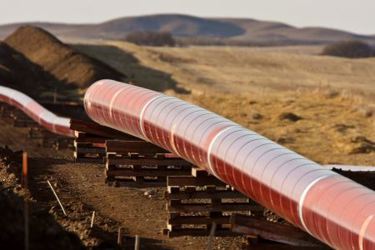Can A Pipeline Really Bring Drinking Water From Mississippi To The West?


With water scarcity growing across the world, water systems are getting creative in how they’re meeting consumption demand. For instance, Israel has launched the world’s first project to channel desalinated water into a natural body and Los Angeles is exploring a billion-dollar plan to supply more of its drinking water from local sources.
But few solutions would be as ambitious as diverting water from flooded regions halfway across the country to those places that are most parched, as was recently suggested in the Los Angeles Times.
“Why not begin a grand national infrastructure project of building a water pipeline from those flooded states to the Southwest?” a letter to the editor asked. “Specifically, start with a line from the Mississippi River to the Colorado River at Lake Powell, where a seven-state compact divvies up the water…. The main pipeline would span about 1,000 miles from Jackson, Miss. along the southern borders of Colorado and Utah to Lake Powell.”
But the idea of building such a pipeline, feeding thirsty regions of the U.S. with the excess from those flooded ones, has been floated before. Ultimately, the costs of those previous projects have appeared to outweigh their benefits.
“This is not the first proposal to find water for the Southwest,” the Desert Sun noted in a response to the proposal. “One such scheme, made more than 50 years ago, would have brought water from Alaska and Canada to feed into the Columbia, Missouri, and Colorado River systems. Aside from international political and environmental considerations, the proposal was sunk by a forecast return on investment of about 5 cents for every dollar invested.”
The Sun noted that this latest proposal has some unique challenges of its own as well. The proposed solution would require a pipeline that’s twice as long as the Alaska Pipeline at a 320-times greater flow rate. It would be four times as long as the California Aqueduct and have to divert more than twice as much water. And, perhaps most challenging of all, it would have to overcome a net elevation difference of 3,700 feet, with peak elevations necessitating unfeasible power generation.
“The power requirement of the flow would require at least the equivalent capacity of about 5 1/2 times the power output of the new Plant Vogtle nuclear facility in Georgia,” per the Sun. “Plant Vogtle has been estimated to cost over $28 billion. Thus, our water pumping scheme would incur a cost of $150 billion for the power plants alone.”
So, while there’s no question that the need for additional source water in the West is great, it seems that using such a massive infrastructure project to solve it might be out of the scope of reality. Still, as drought rages on, there may be no proposed solution too lofty to solve it.
To read more about drinking water projects meant to combat drought, visit Water Online’s Water Scarcity Solutions Center.
